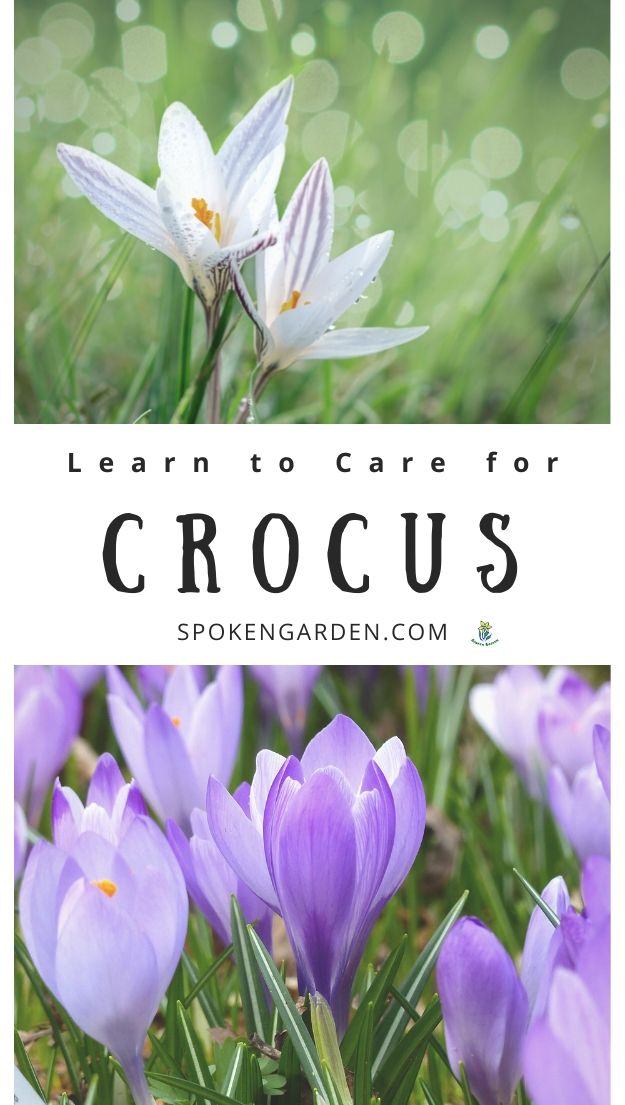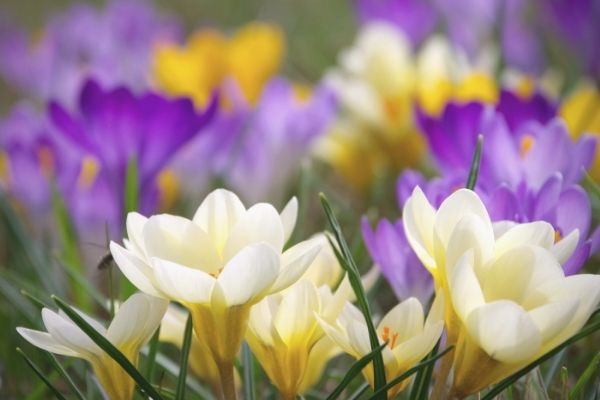Learn all about spring-blooming crocus flowers in this gardener’s guide of these beautiful perennials, including plant care, companion plants, flower uses, and more.
Spring crocus flowers push their way through the ground in mid to late winter and mark the beginning of spring, depending on your local climate.
First breaking through the soil with their thin, grass-like leaves, the flowers then emerge in vibrant hues of yellow, white, purple, and pink. Get some green flower stakes here.
A drab, winter garden cannot help but rejoice the arrival of these beautiful flowering bulbs.
In this crocus plant profile, you’ll learn about the unique characteristics of this plant as well as basic plant care and companion plants for your landscape.
Quick Plant Care Facts
| Sun Exposure | Thrive in full sun while blooming, but then light shade afterward in warmer climates. |
| Water Needs | Regular watering while growing and flowering. |
| Soil Needs | Any well draining soil will do. |
| Cold-Hardiness Zones | USDA hardiness zones 3 to 8. |
| Bloom Time | Late winter to early spring. |
| Flower Colors | White, yellow, orange, purple, red, gold, pale-blue, pink, violet, lilac, and color combinations, along with petals fringed and some frilly. |
| Mature Height/Width | Grows with grass-like leaves with silver mid-rib on each leaf growing straight up from 3 to 6+ inches high. Bulbs will multiply year by year to to spread, but each plant only with grass-like leaves takes maybe an inch in width, so mass plantings are great, but single bulbs are still striking, too. |
| Plant Spacing | For dense plantings, plant each corm-bulb 1-2 inches apart in the fall months. For more open areas and room to grow/ with less need for any weed control, spacing can be more 3+ inches or more a part from each other. When planting around other plants, unless they are deciduous trees or shrubs, plant far enough away so each corm-bulb will get full sun during most of the day at that location. |
If you are looking for Summer Flowering Bulbs to add to your garden, look no further than our ebook
21 Spring-Planted Bulbs For Fantastic Summer Color!
It’s has 60+ pages of summer flowering bulb inspiration and you can get to know the different plant care needs of these 21 gorgeous spring-
planted, summer-flowering bulbs. Whether you are already familiar with bulbs or are just learning about them, this guide explains what bulbs are, defines the 5 different types of bulbs, the correct planting orientation for each of the 5, and much more.
You also get to know each of these 21 spring-planted, summer-flowering bulbs intimately for their care needs like where they will grow, when they flower, different flower colors they are available in, and which online-retailers you can buy your very own to then add to your garden.
Grab your copy now and start planning your spring and summer flower garden TODAY!
This post will teach you the skills you’ll need to care for your crocus bulbs before and after they bloom. If you are new to gardening and want to add these to your landscape but you’re scared you might kill them with your black thumb, don’t worry. We’ll teach you how to plant your spring-flowering crocus bulbs properly in the fall then care for them after.
In the end, you’ll have the confidence needed to grow and care for them on your own.
Let’s get started on your journey to spring crocus plant care!
Quick Word on Crocus Care This Spring
Spring Crocus: Why You Should Love Them
These amazing plants are very subtle and sneaky until they flower because they literally pop out of the ground. Seriously. Even better is if you forgot about planting crocus corms the previous fall season, then you’d be in for a fun surprise.
Besides flowering when most plants are still dormant, they are super easy to care for and require little maintenance besides some watering during drier times.
If you want to add color to your garden, their flowers bloom in striking hues of yellow, orange, red, white, purple, or even a pale-blue. Additionally, their foliage has silver-centered, grass-like leaves.
Depending on your climate, these beautiful, cup-shaped flowers will bloom mid-February through April.
An interesting fact is that the spice saffron is derived from a certain species of fall-blooming crocus, Crocus sativus.
Furthermore, crocuses are perfect for flower borders, mass plantings, cottage gardens, hanging baskets, or containers. Really, you can plant them just about anywhere.
As you can see, this plant is a great addition to anyone’s garden for so many reasons.
Planting Crocus Bulbs in the Lawn
Crocus Flowers: History and Uses
As you begin your journey to understand more about crocus care, a good place to start is to first learn about their family group, their history, and their uses. Read on below for more!
Iridaceae Family
Crocus flowers are in the Iridaceae family. Also known as the Iris family, this family group has more than 300 species of flowering plants throughout the world.
The iris family features some of the most popular flowers including quite a few you have probably heard of before.
Crocus family members are valued for a range of uses, including:
- Cut flowers
- Ornamental gardens
- Perfumes
- Aromatherapy
- Gins
- Spices
- Other medicinal uses
Other members of the large Iridaceae family include Gladioli, Irises, and Freesias.
History of Crocus (in Brief)
Spring-blooming crocus flowers are found in the wild in high alpine regions of northern Europe, including the Alps. This alpine C. vernus is the main ancestor of the common garden crocus we see today, according to the Pacific Bulb Society.
The history of the crocus bulb actually traces back to 2100-1600 BC, or even earlier.
Crocus flowers were grown and used by the ancient Egyptians, Greeks, and Minoans in various ways. For example, the saffron from C. sativus (a fall-blooming crocus species) was used to dye both hair and textiles. The flowers were also worn in women’s hair and used as cosmetics. Furthermore, there are records of Egyptians using crocus medicinally.
Whether referring to fall-blooming or spring-blooming species, the name “Crocus” is one of the most ancient plant names. The name has been traced back to the Latin adjective crocatus which means “saffron yellow.” In addition, Greek culture used the word “Krokos” to indicate “saffron” as well.
One of the first bulbs brought to the New World, they were heavily traded throughout Europe.
By the early 1600s, crocus bulbs made their way to the Netherlands where many varieties were introduced that are still around.
Today, crocus flowers are enjoyed by many gardeners due to their variety of colors, sizes, and landscaping possibilities. They are enjoyed around the world in fall, winter, and spring gardens.
Uses for Crocus
As we stated in the history section above, crocus flowers were used as long ago as Ancient Greece and Ancient Egypt mostly for cosmetic and medicinal purposes.
More recently, people still extract saffron from the flower of C. sativus which is a very expensive spice.
C. vernus is not edible and should never be ingested. It is mainly used as an ornamental flower.
Spring-Flowering Crocus Companion Plants
Crocus bulbs will return each spring season after season, therefore, they could have a lot of options for friends.
You really cannot go wrong with a companion for your flowering crocus bulbs. It simply boils down to your individual preference, color choice, and sunlight needs.
Companion plants to consider:
- Violas, like Johnny Jump Ups
- Pansies
- Daffodils,
- Tulips
- Grape Hyacinth
- Alliums
- Hyacinth
Crocus Bulbs in Containers
Crocus bulbs would make a great addition to an early spring-blooming container, especially if you are low on space.
With their variety of color and spring bloom time, they can enhance your landscape with color and interest.
Another fun option is to plant your crocus with your spring-blooming daffodils or tulips, along with pansies and other plants for a fun container.
Flowering Crocus Bulbs Conclusion
As you’ve read above, spring crocus flowers will add color to your drab winter garden beginning in mid to later winter. Plus, they are very easy to maintain.
Planting crocus bulbs in the fall season and being mindful of their growth needs, your bulbs should pop with color for seasons to come.
Now we want to hear from you!
What other questions do you have about crocuses that we didn’t answer above? Let us know by leaving a quick comment below. Thanks!
Want to learn about other plants in your garden? Check out some of our previous plant profiles:
- Daffodils: A Gardener’s Guide and Plant Profile
- Crocosmia: A Gardener’s Guide and Plant Profile
- Primroses: A Gardener’s Guide and Plant Profile
- Tulips: A Gardener’s Guide and Plant Profile
- Grape Hyacinth: A Gardener’s Guide and Plant Profile
- Winter Pansies: A Gardener’s Guide and Plant Profile
See you in the garden!
~ Sean and Allison
P.S. Find us on Pinterest, Twitter, Facebook, and Instagram so you don’t miss a thing!
Crocus References:
- Missouri Botanical Garden “Crocus vernus”
- Pacific Bulb Society “Crocus“
- University of California Extension “Crocus“

Learn all about Crocuses in this gardener’s guide of these beautiful perennials, including plant care, companion plants, uses, and more.



